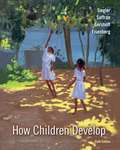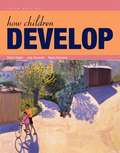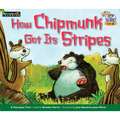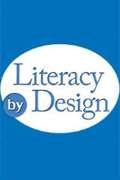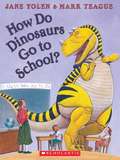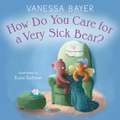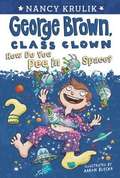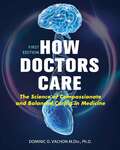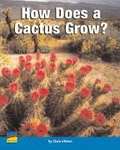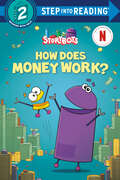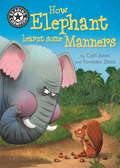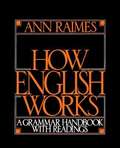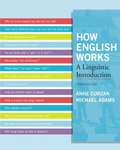- Table View
- List View
How Can We Provide Freshwater To Those In Need? Student Activity Guide
by Carolina Biological Supply Company Smithsonian Science Education CenterNIMAC-sourced textbook
How Can We Use the Sky to Navigate?: Student Activity Guide
by The Smithsonian InstitutionNIMAC-sourced textbook
How Children Develop
by Nancy Eisenberg Robert Siegler Elizabeth Gershoff Jenny SaffranHow Children Develop has established itself as the topically organized textbook teachers and researchers trust for the most up-to-date perspectives on child and adolescent development. The authors, each a well-known scientist and educator - have earned that trust by introducing core concepts and impactful discoveries with an unparalleled integration of theory, cultural research, and applications, all in a style that is authoritative yet immediately understandable and relevant to students. <p><p> The new edition has been rigorously updated and welcomes co-author Elizabeth Gershoff (The University of Texas at Austin), who brings a breadth of research and teaching experience to the discussions of social and emotional development. It is also more interactive than ever before, with richer integration between the book and its interactive study features in LaunchPad.
How Children Develop
by Robert S. Siegler Judy S. DeLoache Nancy EisenbergWorth is proud to publish the Third Edition of How Children Develop by Robert S. Siegler, Judy S. DeLoache, and Nancy Eisenberg—the leading textbook for the topically-organized child development course. Providing a fresh perspective on the field of child development, the authors emphasize fundamental principles, enduring themes, and important recent studies to provide a unique contribution to the teaching of child development.
How Chipmunk Got Its Stripes: A Pourquoi Tale
by Brooke Harris Juan Bautista Juan Oliver Laura StromDo you know why all chipmunks have three stripes down their backs? This pourquoi tale gives a creative explanation as to how this happened. This tale originated with the Seneca Indians.
How Did They Do That?: Built for Speed; Mind-Boggling Bridges
by Anastasia Suen Ellen DreyerNIMAC-sourced textbook
How Do Dinosaurs Go to School? (Elementary Core Reading Ser.)
by Jane Yolen Mark TeagueNIMAC-sourced textbook <P><P>School has never been so much fun! Come along for a very unusual day and laugh out loud as the dinosaurs enjoy story time, show-and-tell and recess.
How Do Weather And Climate Affect Our Lives?: Student Activity Guide
by The Smithsonian InstitutionNIMAC-sourced textbook
How Do You Care for a Very Sick Bear?
by Vanessa BayerFrom debut children's author Vanessa Bayer and illustrator Rosie Butcher, How Do You Care for a Very Sick Bear? is a sweet picture book with advice for children—and adults—for dealing with a sick friend.You and your friend Bearare an excellent pair.But if your friend gets sick, And can’t do all the things that you two love to do…You may wonder--how do you care for a very sick Bear?When someone dear is dealing with illness, it's difficult to know what to do or say. The actor Vanessa Bayer experienced this firsthand when she was treated for childhood leukemia. In her first children's book, she offers gentle, reassuring advice that people of all ages will appreciate.
How Do You Pee in Space? #13
by Nancy Krulik Aaron BlechaA real-life astronaut is coming to Edith B. Sugarman Elementary School, and one lucky kid gets to interview him! Not only that, a trip to a space adventurer program is also up for grabs. To win the contest, students must complete a physical fitness challenge and come up with three interesting questions to ask the astronaut. As always, George intends to beat his rival, Louie. But when the competition heats up, George is too distracted to notice how much the prize means to his best friend, Alex. For George, winning may not be everything this time around.
How Doctors Care: The Science of Compassionate and Balanced Caring in Medicine
by Dominic O. VachonCompassion draws physicians into medicine, but then they believe they must jettison that compassion to survive. Paradoxically, science has now shown that losing that compassion not only harms the patient, it also harms the doctor. How Doctors Care: The Science of Compassionate and Balanced Caring in Medicine explains what physicians and other clinicians can do to provide balanced and compassionate caring for patients without becoming emotionally detached or overwhelmed. <p><p>The text provides a research-informed and non-sentimental description of physician/clinician compassion. Bringing together cutting-edge scientific research for practicing physicians and those in training, How Doctors Care provides the first full articulation of what constitutes optimal compassionate mental performance in the practice of medicine. It argues how maintaining this internal state is the key to physician resilience and fulfillment in a dysfunctional healthcare system. <p><p>Rather than blaming clinicians for burnout, How Doctors Care argues that healthcare organizations must provide organizational protection and support to clinicians so that they are able to maintain the compassionate internal state they desire so much and that benefits patients the most.
How Does a Cactus Grow?
by Clare O’brien Vicki Rushworth David HaggertyIn this book, learn how cacti grow from seeds and survive in the harsh desert environment.
How Does a Tree Help? (Into Reading, Level B)
by David Bauer<p>NIMAC-sourced textbook <p>All kinds of animals make their homes in trees. Children do, too!</p>
How Does Money Work? (Step into Reading)
by Scott EmmonsThe robots from Netflix's StoryBots Answer Time star in an all-new Step 2 Step into Reading leveled reader!Bing wants to know what money is and why we use it. His questions lead him from a bank to a tour of a successful lemonade stand. What he learns will fascinate children ages 4 to 6 who love Netflix's educational show.Step 2 Readers use basic vocabulary and short sentences to tell simple stories. For children who recognize familiar words and can sound out new words with help.
How Does Motion Energy Change in a Collision?: Student Activity Guide
by The Smithsonian InstitutionNIMAC-sourced textbook
How Elephant Learnt Some Manners: Independent Reading 12 (Reading Champion #511)
by Cath JonesThis story is part of Reading Champion, a series carefully linked to book bands to encourage independent reading skills, developed with Dr Sue Bodman and Glen Franklin of UCL Institute of Education (IOE). This book is aimed at Independent Reading 12, for readers aged 7 years old and up, or in the second half of Year 3.Elephant is the biggest and also thinks he's the best. He's always a bit rude to the other animals, until some clever squirrels teach him a lesson.Reading Champion offers independent reading books for children to practise and reinforce their developing reading skills.Fantastic, original stories are accompanied by engaging artwork and a reading activity. Each book has been carefully graded so that it can be matched to a child's reading ability, encouraging reading for pleasure.The Key Stage 2 Reading Champion Books are suggested for use as follows:Independent Reading 11: start of Year 3 or age 7+Independent Reading 12: end of Year 3 or age 7+Independent Reading 13: start of Year 4 or age 8+Independent Reading 14: end of Year 4 or age 8+Independent Reading 15: start of Year 5 or age 9+Independent Reading 16: end of Year 5 or age 9+Independent Reading 17: start of Year 6 or age 10+Independent Reading 18: end of Year 6 or age 10+
How Elephant Made Peanut Butter
by Lesli Favor Marcin Piwowarski Lori O'DeaHow can an elephant feed his friends? The forest animals gather for lunch, but no one has any food. Can Elephant get them to try his idea?
How English Works: A Grammar Handbook with Readings
by Ann RaimesThis book uses readings from newspapers, works of non-fiction, and college textbooks to illustrate the use of target structures. The Student's Book provides clear presentations of the basic principles of 27 important areas of English grammar, through a wide variety of exercises and tasks for writing and editing. It engages students with topics that range from artificial intelligence and laptop computers to the environment and economics. This important grammar text provides a real-world context that allows students to see how the English language really "works. "
How English Works: A Linguistic Introduction
by Martin Sandler Edwin Rozwenc Edward. Martin Michael Adams Anne CurzanThis accessible introduction to the structure of English, general theories in linguistics, and important issues in sociolinguistics, is the first introductory linguistics textbook written specifically for English instructors and educators. Focuses on issues such as American dialects, descriptive and prescriptive approaches to English grammar, the history of English, English spelling, stylistics, language attitudes, and language education. Tapping into our natural curiosity about language, it invites readers to connect academic linguistics to everyday use of the English language and to become active participants in the construction of linguistic knowledge. The third edition provides updated examples of current language change--including new slang and other word coinages, grammatical developments, and sound changes--as well as new research findings on American dialects, language acquisition, language evolution, eggcorns, English and the Internet, and much more. For anyone interested in the structure of English, general theories in linguistics, and important issues in sociolinguistics.

